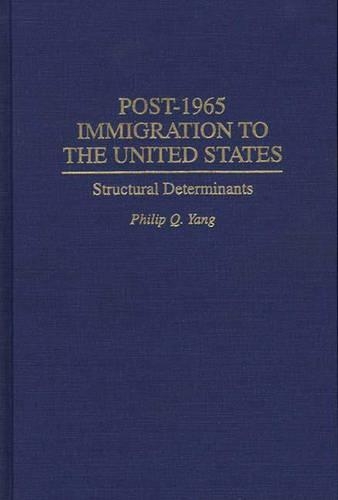
Post-1965 Immigration to the United States: Structural Determinants
(Hardback)
Publishing Details
Post-1965 Immigration to the United States: Structural Determinants
By (Author) Philip Q. Yang
Bloomsbury Publishing PLC
Praeger Publishers Inc
14th February 1995
United States
Classifications
Tertiary Education
Non Fiction
Civics and citizenship
304.873
Physical Properties
Hardback
248
Width 156mm, Height 235mm
595g
Description
Why do countries differ substantially in the size of legal permanent immigration to the United States since 1965, even after the repeal of the discriminatory national origins quota system The author demonstrates that development theory, world system theory and immigrants' social network theory all contain partial truths, but not one of them captures the entire immigration process. Here cross-national differences in the size of post-1965 immigration are shown as the outcomes of multi-dimensional forces, including the source country's development, U.S. involvement in the country, immigrants' resources, and the interactions of these factors. Scholars and readers interested in immigration, demography, sociology, history, international relations, cross-national analysis and social change will find this book an interesting and useful addition to their list of resources.
Reviews
.,."well worth reading for all those interested in international migration."-International Migration Review
...well worth reading for all those interested in international migration.-International Migration Review
Yang analyzes reasons for the different levels of immigration among sending nations. His answers should enhance understanding of the causes of global permanent migration in the last quarter of the 20th century, sharpen theoretical approaches to international migration, and provide policy guidelines for countries to regulate or control immigration. This solid study is one more resource with which to buy simplistic, traditional approaches to migration studies (e.g., "push-pull" theory), and points toward more integrated theories that highlight complexities in the immigration process and cross-national comparisons. Upper-division undergraduates and above.-Choice
..."well worth reading for all those interested in international migration."-International Migration Review
"Yang analyzes reasons for the different levels of immigration among sending nations. His answers should enhance understanding of the causes of global permanent migration in the last quarter of the 20th century, sharpen theoretical approaches to international migration, and provide policy guidelines for countries to regulate or control immigration. This solid study is one more resource with which to buy simplistic, traditional approaches to migration studies (e.g., "push-pull" theory), and points toward more integrated theories that highlight complexities in the immigration process and cross-national comparisons. Upper-division undergraduates and above."-Choice
Author Bio
PHILIP Q. YANG received his undergraduate education at Zhongshan University (Sun Yat-Sen University), in the People's Republic of China, and his M.A. and Ph.D. at UCLA. He currently teaches in the Department of Sociology at UCLA. His research interests include immigration, citizenship acquisition, ethnicity, social demography, and China's population issues. Most of his articles have appeared in such journals as International Migration Review, Ethnic and Racial Studies, and Population and Environment.
